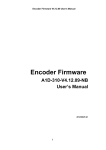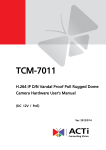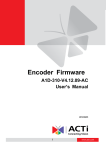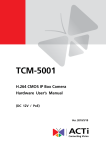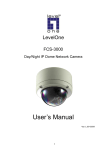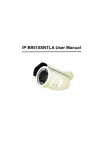Download Encoder Firmware User`s Manual
Transcript
Encoder Firmware A1D-220-V3.10.22-AC User’s Manual i Table of Contents 1. INSTALLATION _______________________________________________ 1-1 1.1 Minimum System Requirements ___________________________________ 1-1 1.2 Preparation before setup _________________________________________ 1-2 1.2.1 1.3 Setup your PC network ________________________________________________ 1-2 Configuring the IP device _________________________________________ 1-7 1.3.1 Video Display __________________________________________________________ 1-9 ii 1.3.2 PTZ (PT/TZ Camera only) ____________________________________________ 1-13 1.3.3 Host Setting ________________________________________________________ 1-18 1.3.4 WAN Setting _______________________________________________________ 1-20 1.3.5 Date Setting ________________________________________________________ 1-23 1.3.6 Video Setting _______________________________________________________ 1-25 1.3.7 Video Adjustment ___________________________________________________ 1-27 1.3.8 Video Privacy Mask _________________________________________________ 1-29 1.3.9 Camera Setup (CMOS camera models ) __________________________________ 1-30 1.3.10 Camera Setup (PTZ camera modesl) __________________________________ 1-32 1.3.11 Camera Setup (HQ1 camera modesl) __________________________________ 1-34 1.3.12 User Account Management __________________________________________ 1-36 1.3.13 System Info ______________________________________________________ 1-37 1.3.14 Firmware Upgrade ________________________________________________ 1-38 1.3.15 Factory Default ___________________________________________________ 1-39 1.3.16 Save Reboot _____________________________________________________ 1-40 1.3.17 Logout __________________________________________________________ 1-42 1 INSTALLATION 1. 1.1 Minimum System Requirements CPU Pentinum 4 2.4GHz and above Hard Disk 40 GB or above Memory 256 MB or above Operating System Windows XP with SP2 or above. IE6.0 SP2. IE7.0 only. Video Resolution SVGA or XGA with 1024x768 resolution 1-1 1.2 Preparation before setup Our IP device provides access through Internet Explorer. You need to set up the network settings and the IP address for the IP device. Please make sure all connections are properly connected, then follow the provedures below. 1. Setup your PC network The IP address for your PC must be within the same subnet as the IP device. You need to match the TCP/IP settings between PC and IP device before you can access it via IE. 2. Setup IP device’s IP address This IP device’s IP address can be assigned manually or acquired automatically by network service (DHCP). If it acquires the IP address by using the DHCP service, please use the IP utility software bundled in the product CD to find the IP address for all IP devices. 1.2.1 Setup your PC network To set up the network of IP device via a PC, you have to change the TCP/IP settings of the PC. The following are the default network settings of IP device. IP Address: 192.168.0.100 Subnet Mask: 255.255.255.0 To access the IP device, the IP address of the PC should match the address below. IP Address: 192.168.0.xxx Subnet Mask: 255.255.255.0 NOTE: xxx should be a number from 1 to 254 except 100, which is used by the IP device. Please also make sure that no two equipments use the same IP address in the same network. 1-2 The procedures below is the setup procedure on Windows XP. If you use operating system other than Windows XP, please refer to OS manuals for proper setup procedures. 1-3 STEP1 Start up your PC. STEP2 Click the [Start] and select the "Control Panel" STEP3 Double-click the "Network and Internet connections" icon. STEP4 Double-click the "Network connections" icon 1-4 STEP5 Click “Local Area Connections”, and then click “Change settings of this connection” in the network Task menu. STEP6 Click “Internet Protocol (TCP/IP)”, and then click the [Properties] button. If you have both IPv4 and IPv6, choose IPv4. 1-5 STEP7 Click the “Use the following IP address” radio button and enter the IP address and the subnet mask. Please set the settings as below. IP address: 192.168. 0.xxx Subnet mask: 255.255.255. 0 (NOTE: xxx should be a number from 1 to 254 except 100, which is used by the IP device. Please also make sure that no two equipments use the same IP address in the same network..) STEP8 Click the [OK] button and the window dialog box closes. 1-6 1.3 Configuring the IP device This section describes how to configure the IP device. The administrator has unlimited access to all settings, while the normal user can only view live video. The IP device is configured under a standard browser (Microsoft Internet Explorer 6.0 or above). Follow the procedures below to configure the IP device. STEP1: Open a browser STEP2: Enter the IP address of the IP device. The default IP address is “192.168.0.100” The “Login Page” is now displayed as below. STEP3: Enter account name (factory default: Admin) and password (factory default: 123456). NOTE: Internet Explorer 6.0 or above is highly recommended. You may download it from http://www.microsoft.com/windows/ie/downloads/default.mspx 1-7 STEP4: Select the language of the IP device user interface. You can select from English, Traditional Chinese, Simplified Chinese, Japanese, Spanish, Italian, German, Portuguese, Czech, French, Finnish, Hungarian and Danish. This user interface setting will disappear once you log out, if you want to change the default user interface language, please change the setting of [Host setting] after login. STEP5: Click the button to login or click the to re-enter account and password. button Once you log in successfuly, the “Video Display page” will be shown as below. 1-8 1.3.1 Video Display 1.3.1.1 Megapixel CMOS camera This section tells you how to view live video via Internet Explorer. STEP1: Click the [Video Display] on the “Main Setup page”. The “Video Display page” is displayed as below. STEP2: Check the [MPEG4/MJPEG] to select the Compression type. Once selected, the video server/IP camera will start to stream with the new compression method. STEP3: Click the [Scale Down] checkbox to scale down the SXGA(1280x1024)/720P(1280x720) to VGA resolution. STEP4: Check the [Mute] checkbox to mute or play audio from the video server/IP camera. STEP5: Click the [Audio Out] checkbox to enable/disable audio transmission from this PC to IP device’s audio out and change audio 1-9 out volume. Ex: With this function enabled you can speak to the people at the IP device site. STEP6: Click the by DO1. [DO1] Button to trigger / untrigger DO function STEP7: Click the [DO2] Button to trigger / untrigger DO function by DO2. STEP8: Click the Setup page”. [Quit] to exit the live view and return to “Main NOTE: If the streaming is disabled, you cannot see the live images here. NOTE: For all network router/switches connected to this Camera/Video Server, be sure to use Auto Negotiation as the Network Connections Type. This will enable the whole network to always run at the highest possible speed. Please also refer to Network Speed & Duplex settings in Host Setting section on Page 23 of this manual 1-10 1.3.1.2 PTZ or PT camera T This section tells you how to view live video via Internet Explorer. The PTZ function is available only to “root” user(Factory default: Admin /123456). Other users cannot see this command. STEP1: Click the [Video Display] on the “Main Setup page”. The “Video Display page” is displayed as below. STEP2: Check the [MPEG4/MJPEG] to select the Compression type. Once selected, the IP camera/video server will start to stream with the new compression method STEP3: Check the [Mute] c checkbox to mute or play audio from the video server/IP camera. STEP4: Click the [Audio Out] checkbox to enable/disable audio transmission from this PC to the IP camera/video server’s audio out and change audio out volume. Ex: With this function enabled you can speak to the people at the IP device site. 1-11 STEP5: Click the function by DO1.. STEP6: Click the [DO1] Button to trigger / untrigger DO [DO2] Button to trigger / untrigger DO function by DO2. STEP7: Click the Setup page”. [Quit] to exit the live view and return to “Main STEP7: Click the [PTZ] to Show “PTZ Control Window”. NOTE: If the streaming is disabled, you cannot see the live images here. NOTE: For all network router/switches connected to this Camera/Video Server, be sure to use Auto Negotiation as the Network Connections Type. This will enable the whole network to always run at the highest possible speed. Please also refer to Network Speed & Duplex settings in Host Setting section on Page 23 of this manual. 1-12 1.3.2 PTZ (PT/TZ Camera only) This section tells you how to control the camera. Click the [PTZ] on the “Main Setup page” to show PTZ control panel. Select a page in “PTZ Panel ” There are three main pages: PTZ, Preset and Tour. You also can control camera from preview display with mouse. PTZ Page PTZ function Help Parameters Page switch Button 1-13 Description Click these buttons to switch between “PTZ”, “Preset” and “Tour” pages Pan Speed Select the pan speed. Tilt Speed Select the tile speed. Zoom Speed Select the zoom speed. Zoom Click + button to zoom in, - button to zoom out. Auto Focus Click check box to enable auto focus.(PTZ camera only) Focus Click these buttons to adjust focus to near or far. PT Control Click each button to do pan and tilt control. Home Click this button of go to home function. Reset Click this button of reset the pan/tilt/zoom function. Auto-scan Click to start scan between left limit to right limit continuously. Auto-scan Speed Select the auto-scan speed. 1-14 Auto Scan recovery Click the check box to enable auto-scan recovery function IAny manual operation will interrupt camera autoscan. If there's no further manual operation for X seconds(recovery time), the camera will resume autoscan. Recover time Set the recovery time. It has to be larger than 1. Preset point Click these buttons to move your camera to your desired preset points. Preset Page: ■Preset Page Help Parameters Preset Info Set Preset Goto Preset Delete Preset Description Show preset number and preset name. You can click to edit the preset name Click this button to save current preset name and PTZ position to this preset point Click this button to go to the PTZ position memorized for this preset point. Click to clear the preset point Information, including preset name and preset PTZ position. Tour Page ■Tour Page Help Parameters Tour Group ID 1-15 Description Select a tour group to start or to edit. There are 10 groups available Start Tour Click to start the tour selected Edit/ Cancel Click to edit or cancel the tour setting. Preset Name Select a preset to be added in this preset tour Time Enter the interval of time for the camera to stay in this preset point in this preset tour. This time includes the time it move from previous preset point to this preset point Add Preset Point Click to add preset point in this preset tour Preset Point Click to select preset point. Select Apply Click to apply the tour setting. Move one earlier Click to move this preset point one earlier in queue. Move one later Click to move this preset point one later in queue. Move to first Click to move this preset point to the first in queue. Move to last Click to move this preset point to the last in queue. Goto Preset Click to go to the PTZ position for this preset point. Preset Del Click to remove the preset point from this preset tour. Note, the settings of this preset point will NOT be deleted Mouse Control: You can click on the preview window to directly control Camera PTZ movements. The closer your cursors are to the edge, the faster the camera will move in Pan and Tilt. To Zoom in and out, move the cursor close to the center and click when the cursor changes to the + or – sign. NOTE: This function is valid only AFTER you click the “PTZ” and the “PTZ panel” is displayed. 1-16 ■Mouse PTZ Help Parameters Description Click area 1 to P/T with fast speed Click on area 2 to P/T with normal speed Click on area 3 to P/T with slow speed Click on area 4 to do zoom in. Click on area 5 to do zoom out. Mouse wheel Use mouse wheel to do zoom in and zoom out. NOTE: Once you finish all settings, be sure to click the [Save Reboot] button. Otherwise, some settings may not take effect. 1-17 1.3.3 Host Setting This section tells you how to setup IP device’s host settings and LAN settings. STEP1: Click the [Host Setting] on the “Main Setup page”. The “Host setting page” is displayed as below. STEP2: Configure these settings with reference to the table below. If you are still unsure what to set, contact your system administrator. ■Host Setting Parameters Host name Language 1-18 Description Enter a host name, and this host name will be shown when you use the IP utility or the SDK to search for the IP device. Select the language of default user-interface. Every user will see the default user-interface first when logging in. ■Network link speed & duplex Parameters WAN port Description This item lets you select the network transmission speed of WAN port. You can select from 1. Auto detect (default setting) 2. 100Mbps / Full duplex 3. 100Mbps / Half duplex 4. 10Mbps / Full duplex 5. 10Mbps / Half duplex ■ToS (Type of Service) Parameters TOS (type of service) TOS priority Description Select whether to add the TOS tag onto the streaming data. Streaming data with a higher priority TOS tag will be transmitted first while compared with other data to be transmitted. Select the TOS tag’s priority to be added onto the streaming. You can select between 1. Normal-Service 2. Minimize-Cost 3. Maximize-Reliability 4. Maximize-throughout 5. Minimize-Delay ■Port Mapping Parameters Description HTTP port Select the port for this IP device to use HTTP protocol. Search server port1 Search server port2 Select the first port on which software applications can find this IP device with. (e.g. IP utility). Select the second port on which software applications can find this IP device with. (e.g. IP utility). STEP3: Click the [Apply] button for each section to confirm the settings or click the [Reset] button to re-enter the parameters. NOTE: Once you finish all settings, be sure to click the [Save Reboot] button. Otherwise, some settings may not take effect. NOTE: For all network router/switches connected to this Camera/Video Server, be sure to use Auto Negotiation as the Network Connections Type. This will enable the whole network to always run at the highest possible speed. Please also refer to Network Speed & Duplex settings in Host Setting section on Page 23 of this manual. 1-19 1.3.4 WAN Setting This section tells you how to setup IP device’s WAN, DNS server and DDNS server settings. STEP1: Click the [WAN Setting] on the “Main Setup page”. The “WAN setting page” is displayed as below 1-20 STEP2: Configure these settings with reference to the table below. If you are still unsure what to set, contact your system administrator. ■WAN Setting Parameters Dynamic IP address Description Click this to enable IP device’s DHCP function. It will acquire its WAN port IP address from a DHCP server within the same network. (You must have a DHCP server in order to enable this function.) Click this to manually enter the IP device WAN port IP address. IP address: Enter the WAN port IP address. Static IP Subnet mask: Enter the subnet mask of WAN port. If IP address is changed, adjust the subnet mask accordingly. address ISP gateway: Enter the IP address of the gateway (the router). Click this when you connect IP device directly to the xDSL modem. User name: Enter the user name of your xDSL account. PPPoE Password: Enter the password of your xDSL account. Note: You have to click the [Save Reboot] after you click the [Apply button] to let this IP device start xDSL connections. ■DNS server Setting Parameters Primary DNS server Secondary DNS server Description Defines the IP address of the primary DNS server. This is used for identifying this computer by name instead of IP address. The IP address of the secondary DNS server. It will be used once the primary DNS server fails. ■DDNS server Setting Parameters DDNS type Service ISP Host name 1-21 Description Click this to enable IP device’s DDNS function. DDNS function enables user to connect to this IP device by domain name even if its IP address is not static. Click one of the DDNS service providers. You can visit their website to get a DDNS service account for this IP device. Enter the host name of your DDNS service account. (ex: xxxx.dyndns.org) User name Enter the login user name for your DDNS service account. Password Enter the login password for your DDNS service account. STEP3: Click the settings or click the [Apply] button for each section to confirm the [Reset] button to re-enter the parameters. NOTE: Once you finish all settings, be sure to click the [Save Reboot] button. Otherwise, some settings may not take effect. NOTE: For all network router/switches connected to this Camera/Video Server, be sure to use Auto Negotiation as the Network Connections Type. This will enable the whole network to always run at the highest possible speed. 1-22 1.3.5 Date Setting This section tells you how to setup IP device’s date and time settings. STEP1: Click the [Date Setting] on the “Main Setup page”. The “Date setting page” is displayed as below STEP2: Configure these settings with reference to the table below. If you are still unsure what to set, contact your system administrator. ■Date Setting Parameters SNTP/NTP server Description Click this to enable IP device’s SNTP/NTP function. SNTP/NTP function enables this video to synchronize its time settings with a SNTP/NTP server. You can use this function to make sure all your IP devices’ time is the same. Additionally, with our embedded digital-time-code in the streaming, you can tell the event sequence accurately. IP address: Enter the IP address of the SNTP/NTP server. Sync time: Select the time interval for this IP device to synchronize its time. Click this to manually setup the date & time. Set manually Date : Select the date Time: Select the time Time zone Day Light Saving 1-23 Select the time zone offset for local settings Select Type 1 to specify daylight saving time by week number in a month; select Type 2 to specify daylight saving time by date. Start Time : Select the daylight savings start time. End Time : Select the daylight savings end time. STEP3: Click the [Apply] button of each setting to confirm the settings or click the [Reset] button to re-enter the parameters. NOTE: Once you finish all settings, be sure to click the [Save Reboot] button. Otherwise, some settings may not take effect. Manually set date and time will NOT be kept if device loses power. 1-24 1.3.6 Video Setting This section tells you how to setup IP device’s video and streaming settings. STEP1: Click the [Video Setting] on the “Main Setup page”. ■Video setting Parameters Camera name Description The camera name is reserved for customer use. Select the streaming mode. 1. TCP only 2. Multicast only Streaming Method 3. RTP Over UDP 4. RTP Over Multicast 5. RTP Over UDP & Multicast RTSP Authen Check box to enable RTP streaming’s Account/Password authentication. Enable 1-25 RTP B2 Frame Enable Check box to enable the B2 frame in RTP streaming Audio Select enable or disable the audio function. Input Sensitivity Select HIGH or LOW of the audio input sensitivity Multicast IP Select the multicast IP. Default settings is 228.5.6.1 Multicast TTL Select the multicast TTL. Default setting is 255. IGMP This option appears only in Multicast. Enabling it will enable using IGMP membership to do multicast. Resolution Select the video resolution of the IP device. Select the frame rate mode. Constant: The streaming’s frame rate remains constant at all conditions. Frame rate mode Variable: The streaming frame rate will vary according to the amount of motion and change in the scene to maintain proper image quality. Frame rate Encoder Type Video Bitrates Mode Video Maximum Bitrate Bitrate Serial Port Baud Rate Select the frame rate of the video streaming. Select the encoder’s compression type. 1. MPEG4 2. MJPEG Select the video bitrate mode. Constant Bit Rate: The streaming’s bitrate remains constant at all conditions. Variable Bit Rate:: The streaming bit rate will vary according to the amount of motion and change in the scene to maintain image quality.. Select the Maximum bitrate of the video streaming. If the bitrate limit is too low, actual frame rate may also be limited. Doing so will also disable Bit Rate setting below. Select the bit rate of the video streaming. You can select from 28Kbps to 3Mbps. Note: Lower bit rate consumes less bandwidth but delivers lower quality images.High bit rate consumes more bandwidth but delivers higher quality images. Select the Baud Rate setting of serial port. Serial Port Control Select the Control setting of serial port. RTSP port Select the port for this IP device to support RTSP Video RTP Over Multicast Audio RTP Over Multicast Enable/disable the multicast video streaming via RTP protocol Enable/disable the multicast audio streaming via RTP protocol Select the port through which software applications may Video control port control this IP device. Video streaming Select the port through which software applications may establish video streaming with this IP device. port (TCP Only) Video multicast Select the port for this IP device to support video multicast port (Multicast function of the application program. Only) STEP2: Click the [Apply] button to confirm the settings or click the [Reset] button to re-enter the parameters. 1-26 1.3.7 Video Adjustment This section tells you how to adjust the streaming video. STEP1: Click the [Video Adjust] on the “Main Setup page”. The “Video adjustment page” is displayed as below 1-27 STEP2: Check this STEP3: Check this individual region. box to enable motion detection box to enable motion detection for STEP4: Set the sensitivity of motion detection region. STEP5: Set the interval time of motion detection. After a motion event is triggered, no more event will be triggered withing this time in the same region. STEP6: Set the STEP7: In motion activity window , the bar shows the motion activitiy status. You can also see the trigger threshold (Red line). When the motion activity exceeds the trigger threshold, the bar would become red to indicate that a motion event hs been triggered. While viewing the motion activitity window, you can adjust the motion sensitivity (for more or less activities to be triggered) and the threshold (for how many activity would trigger a motion event. If the default settings are not satisfactory for your scene, you may try our alternative recommendations of: trigger threshold of this motion detection region. a. Sensitivity: 80, Threshold: 2~5 (for normal environment) b. Sensitivity: 80, Threshold: 5~10 (for very noisy environment) STEP8: When satisfied with the motion settings, click the STEP9: Adjust the video by changing the value of [Apply] “Brightness”, “Saturation” and “Contrast”. See the images displayed above for the effect of the current setting. STEP10: Check this box to enable DO handler with MD. Click to enable DO1 or DO2 for reponse. Click region to link with this DO. Click be high or low. to Select a MD to dertermine the DO handler to STEP11: When you are satisfied with the video settings, click the [Apply] button of each section to confirm the settings. Otherwise, you may also click the [Reset] to restore previous settings. NOTE: Once you finish all settings, be sure to click the [Save Reboot] button. Otherwise, some settings may not take effect. 1-28 1.3.8 Video Privacy Mask This section explains how to setup video privacy mask.. STEP1: Click the [Video Privacy Mask] on the “Main Setup page”. The “Video Privacy Mask” is displayed as below 1-29 STEP2: Click “setup” button to setup privacy mask region STEP3: Check STEP4: Click the colors to select. STEP5: To change the position, shape and size of the privacy mask, click and drag on the white square at the lower right of the rectangular privacy mask region. STEP6: Click the [Apply] button to confirm current privacy mask settings. You need to wait for 10-15 seconds for new settings to take effect. this box to enable privacy mask function to select the color for privacy mask. There are 4 1.3.9 Camera Setup (CMOS camera model s) This section tells you how to adjust the camera. STEP1: Click the [Camera Setup] on the “Main Setup page”. The “Camera Setup page” is displayed as below ■Camera setting Parameters Video Flipping Check this box to flip the video up-down Video Mirror Check this box to mirror the video left-right Check this box to use best pre-set settings for bundled lens This value controls the level of light where camera switches into night mode. Increasing it will make camera switch to night mode at a darker illumination level. Lens Compensation NightTime Gain Threshold 1-30 Description Select the white balance mode. After you set the parameter, you need to wait for 5~10seconds to see the White Balance Mode final result. 1. AUTO : Auto white balance (default) 2. INDOOR1: Select the indoor white balance profile 1. 3. INDOOR2: Select the indoor white balance profile 2. 4. OUTDOOR1: Select the outdoor white balance profile 1. 5. OUTDOOR2: Select the outdoor white balance profile 2 6. HOLD CURRENT: Select this to let the IP camera automatically obtain a best white balance setting according to current environment. The IP camera will use this setting to adjust color. NOTE: This setting will be lost after you reboot the camera. 7. MANUAL: Select this to enable manual setting of the white balance. You will need to enter the R Gain and B gain setting below. R Gain Add or decrease redness to the video when under Manual (Manual White balance White Balance mode. (This function is only available in Manual White balance mode.) mode only) B Gain (Manual White balance mode only) Exposure mode Exposure Gain Shutter Speed AGC Gain (In auto Exposure mode only) Maximum Auto Shutter Speed (In auto Exposure mode only) Flickless Mode STEP2: Click the settings or click the 1-31 Add or decrease blueness to the video when under Manual White Balance mode. (This function is only available in Manual White balance mode.) Select exposure mode to auto or manual. - Auto: The IP camera will adjust the exposure automatically. - Manual: (In Manual White balance mode only) Manually select the Exposure Gain and Shutter Speed below. Select the Exposure Gain of the IP camera. The higher the value = brighter images. Increase or decrease the shutter speed. The higher the value, the better the nighttime performance. Although higher values also causes motion to become blurry. When exposure mode is auto, IP camera will adjust its shutter speed according to AGC gain and the Maximum auto shutter speed. Higher AGC gain = brighter images. When exposure mode is auto, IP camera will adjust its shutter speed according to AGC gain and the Maximum auto shutter speed. This setting is to set the maximum shutter speed range of this camera. Change settings between 60Hz or 50Hz, depending on the AC power type of your region. [Apply] button of each section to confirm the [Reset] button to re-enter the parameters. 1.3.10 Camera Setup (PTZ camera models) STEP1: Click the [Camera Setup] on the “Main Setup page”. The “Camera Setup page” is displayed as below ■Camera setting Parameters Description Video Flipping Check this box to flip the video up-down Video Mirror Check this box to mirror the video left-right BLC Check this box to enable back light compensation. Select the white balance mode. After you set the parameter, you need to wait for 5~10seconds to see the White Balance Mode 1-32 final result. 1. AUTO : Auto white balance (default) 2. HOLD CURRENT: Select this to let the IP camera automatically obtain a best white balance setting according to current environment. The IP camera will use this setting to adjust color. NOTE: This setting will be lost after you reboot the camera. 3. MANUAL: Select this to enable manual setting of the white balance. Exposure mode AGC Gain Auto IRIS Level Select the Iris level. Sense up Level Select the sense up level. Light Sensor Mode NightTime Gain Threshold STEP2: Click the settings or click the 1-33 Select exposure mode. - Auto: The IP camera will adjust the exposure automatically. - Shutter Priority: The IP camera will adjust the exposure by shutter priority first. - Iris Priority: The IP camera will adjust the exposure by Iris priority first. - Manual: Manually select the Exposure Gain and Shutter Speed below. When exposure mode is auto, IP camera will adjust its shutter speed according to AGC gain and the Maximum auto shutter speed. Higher AGC gain = brighter images. Select light sensor mode. - Auto: The IP camera will automatically switch between day or night mode according to lighting level - Day: The IP camera will always stay in day mode. - Night: The IP camera will always stay in night mode. This value controls the level of light where camera switches into night mode. Increasing it will make camera switch to night mode at a darker illumination level. [Apply] button of each section to confirm the [Reset] button to re-enter the parameters. 1.3.11 Camera Setup (HQ1 camera models)* This section applies only to ACM-58x1 / ACM-78x1. Some functions listed here may not be available to all models. STEP1: Click the [Camera Setup] on the “Main Setup page”. The “Camera Setup page” is displayed as below ■Camera setting Parameters Description Video Mirror Check this box to flip the video up-down BLC Check this box to mirror the video left-right White Balance Mode Select the white balance mode. After you set the parameter, you need to wait for 5~10seconds to see the final result. 1-34 Exposure mode AGC Gain Line Freqeuency Flickerless Mode 4. AUTO : Auto white balance (default) 5. HOLD CURRENT: Select this to let the IP camera automatically obtain a best white balance setting according to current environment. The IP camera will use this setting to adjust color. NOTE: This setting will be lost after you reboot the camera. 6. MANUAL: Select this to enable manual setting of the white balance. Select exposure mode. - Auto: The IP camera will adjust the exposure automatically. - Shutter Priority: The IP camera will adjust the exposure by shutter priority first. - Iris Priority: The IP camera will adjust the exposure by Iris priority first. - Manual: Manually select the Exposure Gain and Shutter Speed below. When exposure mode is auto, IP camera will adjust its shutter speed according to AGC gain and the Maximum auto shutter speed. Higher AGC gain = brighter images. Change settings between 60Hz or 50Hz, depending on the AC power type of your region.. Enable the flickerless or disable the flickerless mode Select the day/night mode. 1. Auto: The camera would automatically switch between day and night mode according to lighting levels. It will follow the Day Gain and Night Gain Day/Night mode threshold defined by user below. 2. Day : The camera will stay in day (color) mode. 3. Night: The camera will stay in night (black & white) mode. The camera will use the method selected here to determine when to do day/night switch. Use CdS sensor when the camera is generally in the Trigger Source same lighting condition as the view area. Use ISP if the camera itself has a different lighting condition from the view area, or if you wish to have a finer control for Day/night switch. We recommend using CdS as default. The camera would switch to night (black & white) based Night Gain upon lighting conditions. Increasing it will shift the Threshold switching point darker. The camera would switch to day (color) mode ased upon Day Gain lighting conditions. Increasing it will shift the switching Threshold point darker. Select IR Cut Filter Mode: 1. Auto: Default mode, IRCut filter mode works normally. IRCut Filter Mode 2. Disable: IRCut filter function is disabled.In this mode, The video will remain in color mode when entering night mode. Select auto mode if you want IR LED to work normally. If you do not wish IR LED to turn on when in night mode, IRLED Switch Select disable mode. 1-35 STEP2: Click the [Apply] button to confirm the settings or click the [Reset] button to re-enter the parameters. 1.3.12 User Account Management This section tells you how to setup the accounts. STEP1: Click the [User account] on the “Main Setup page”. The “Account management page” is displayed as below STEP2: Setup the account names and their respective passwords. There are 1 root (administrator) account and 10 common user accounts allowed. Root(administrator) account allows the user to watch the live view and modify all settings. The common user account only allows live video view, and cannot change settings. STEP3: Click the the [Apply] button to confirm the settings or click [Reset] button to re-enter the parameters. NOTE: Once you finish all settings, be sure to click the [Save Reboot] button. Otherwise, some settings may not take effect. 1-36 1.3.13 System Info This section tells you how to see the system information of this IP device including system information, WAN status and system log. STEP1: Click the [System info] on the “Main Setup page”. The “System information page” is displayed as below STEP2: View the information at the 3 columns. This information is very useful to understand the IP device status and to resolve any problem that might occur. ■System info Column System info WAN status System log Description It shows the firmware version, MAC address, production ID, and factory default type of IP device. It shows the WAN port’s IP address, netmask, gateway, DNS server, DDNS host and connection status. It shows the system event. This column is very useful as a diagnostic tool. STEP3: Click [Parameter List] where you may see all configurations of the IP device. 1-37 STEP4: Click [Server Report] to export related information of the IP device whilecontactingto your support channel. 1.3.14 Firmware Upgrade This section tells you how to see update IP device’s firmware. You can always visit our web site for the latest firmware. STEP1: Click the [Firmware] on the “Main Setup page”. The “Firmware upgrade page-1” is displayed as below STEP2: Click [Apply] button. The ‘’firmware upgrade page-2” will be displayed as below. ■Date Setting Parameters Firmware images file MD5 file 1-38 Description You can upload the firmware images here. Click the [browse] to select the an image file and click the [enter]. You can always get the latest version at our website. You can upload the MD5 file here. Click the [browse] to select an MD5 file and click the [enter]. You can always get the latest version at our website. NOTE: The version of the firmware image and the MD5 file to be uploaded must be the same, otherwise, the firmware upgrading will fail and the IP device will continue using previous firmware version. STEP3: Click the [Upload] button to start upgrading or click the [Reset] to re-select the files. STEP4: The upgrade process window shows a progress bar indicating upgrade status. STEP5: The progress bar shows the upgrading is completed, and system is rebooting. 1.3.15 Factory Default This section tells you how to load IP device’s factory default setting. 1-39 STEP1: Click the [Factory Default] on the “Main Setup page”. The “Factory default setting page” is displayed as below STEP2: Click the [Apply] button to go to loading confirmation page or click the [Reset] button to exit to previous page. STEP3: A confirmation page will be displayed. Click the [Save Reboot] button to start loading factory default settings. 1.3.16 Save Reboot This section tells you how to save all the settings and reboot this IP device. This is critical because some settings might not take effect before save and 1-40 reboot. STEP1: Click the [Save and reboot] on the “Main Setup page”. The “Save and reboot page” is displayed as below. 1-41 STEP2: The Action LED indicator will go off to indicate that the IP device is rebooting. After around 30 seconds, the Action LED will light up again to indicate that the reboot is completed. 1.3.17 Logout This section tells you how to logout from the IP device. Be sure to logout this IP device once your setting is completed. STEP1: Click the [Logout] on the “Main Setup page”. You will logout and return to the “Login Page” displayed as below. 1-42














































